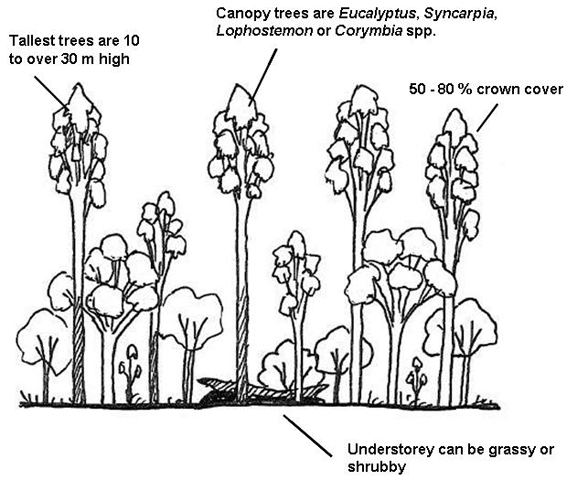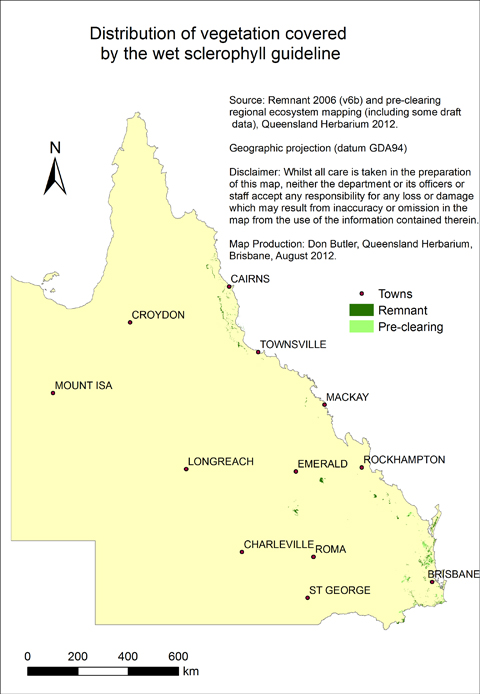Description
What are they?
Wet sclerophyll forest is characterised by very tall eucalypt trees (and their close relatives) which form the upper canopy layer. The trunks of these trees tend to be straighter than those of other eucalypts, and their leafy parts are often concentrated in the top third of the tree.
The understorey of wet sclerophyll forest can contain shrubs and small trees (often with rainforest species) or may be grassy with scattered shrubs.
Where are they?
Wet sclerophyll forest is found in all Australian states except for South Australia and the Northern Territory.
It occurs in areas of high rainfall, often between open-eucalypt forest and rainforest (where present).
In Queensland, wet sclerophyll forest is mostly found in the south-east, and as a narrow strip bordering the western edge of rainforest in the Wet Tropics of Far North Queensland.
Carbon potential
The above-ground parts of woody plants in mature wet sclerophyll forest in Queensland can hold from about 370 to over 1800 tonnes of carbon dioxide equivalent per hectare.
Regrowing wet sclerophyll forest will capture atmospheric carbon and store it in woody plant tissues. The peak carbon accumulation rate is likely to be between 6 and 30 tonnes of carbon dioxide equivalents per hectare per year.
Read more about farming carbon and limits to carbon accumulation.
Restoration and management
Rainfall and past clearing history have a large influence on the potential for reforestation and carbon accumulation in wet sclerophyll forest, but ongoing management is also important.
The intense crown fires that characterise the renewal of wet sclerophyll forest in the southern states are not required for the regeneration of this vegetation type in Queensland.
In Queensland, regeneration of wet sclerophyll canopy trees can be encouraged with low to moderate levels of fire or mechanical disturbance, to reduce the density of shrubs or small trees in the understorey if they become so dense as to preclude eucalypt establishment.
Continuous high grazing pressure, hot fires, dense shrubs, and Bell Miner Associated Dieback will slow and may even prevent the restoration of wet sclerophyll forest, as these will inhibit tree establishment and growth. Hot fires and Bell Miner Associated Dieback can also kill trees.
Livestock grazing can be compatible with reforestation in wet sclerophyll forest, as long as grazing pressure is held at low to moderate levels, and there is enough strategic spelling (periods where grazing is stopped) to allow new trees to establish.
In general, increasing the biomass of trees will reduce the carrying capacity for grazing.
Timber harvesting can be compatible with reforestation in wet sclerophyll forest, although it will slow the rate of carbon accumulation and reduce carbon stocks in the short term.
Wildlife
Regrowing wet sclerophyll forest will benefit wildlife, especially plants and animals that rely on wet sclerophyll forest for habitat.

Features
Wet sclerophyll forest (also known as tall open-forest) is unique to Australia. Generally, wet sclerophyll forest in Queensland has the following features:
- Eucalypts (such as flooded gum (Eucalyptus grandis), blackbutt (E. pilularis), blue gum (E. saligna), red mahogany (E. resinifera)), turpentine (Syncarpia glomulifera), brush box (Lophostemon confertus) and sometimes bloodwoods (Corymbia species) are the tallest trees, and form the upper canopy layer. They can range in height from 10m to over 30m.
- Canopy cover can vary from 50% to 80%.
- The understorey may be composed of rainforest plants, or be grassy with a sparse shrub layer, or be a patchy combination of both.
- Several tree species may be present in the canopy at any one site.
The variation in tree species may relate to the local climate, topography, soil type and management history of the site.

Wet sclerophyll forest occurs in areas of high rainfall, often between open eucalypt forest and rainforest (where present).
In Queensland, wet sclerophyll forest is mostly found in the south-east, and as a narrow strip bordering the western edge of rainforest in the Wet Tropics of far north Queensland.
More information
View the Wet sclerophyll forest Management Guideline .


